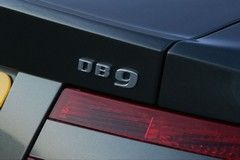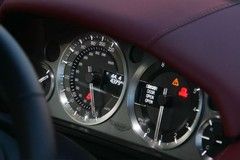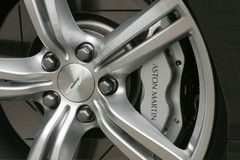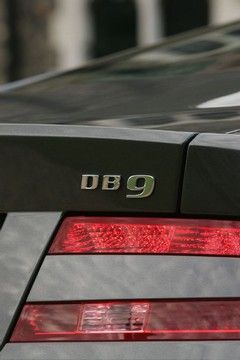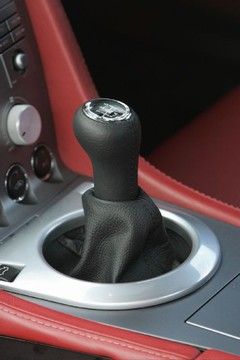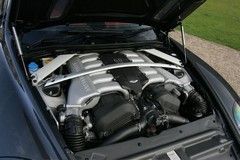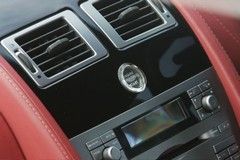Aston Martin DB9 Sports Pack Manual
Ian Kuah reports on this welcome upgrade to Aston Martin's iconic GT

Aston Martin DB9 Sports Pack
With a slightly less powerful version of the sonorous V12 that powers its Vanquish big brother and styling to die for, the Aston Martin DB9 occupies a relatively unpopulated segment of the market, with only the Bentley GT as direct competition.
There is no question that despite its GT, rather than hard-core sportscar credentials, the DB9 is a more charismatic car drive than its British rival from Crewe. Its lower weight, crisp normally-aspirated V12 and intoxicating soundtrack make it a more responsive and engaging drivers’ car than the ballistic twin-turbocharged Bentley GT.
For some drivers however, the DB9 is not focused enough, its excellent paddle-shift operated automatic transmission denies you the challenge of slotting your own ratios just so. In addition, some feel that the relatively good ride was achieved at the expense of ultimate handling prowess on the limit.
Hard core
However, Aston Martin now offers a two prong counter-attack to address these issues for hard-core drivers, in the form of a Sports Pack suspension upgrade and the six-speed manual gearbox promised at the outset. Our test car had both these options, which dramatically change the character of the DB9.
The manual gearbox is the Italian-made Graziano six-speed and specifying it turns the DB9 into a much more concentrated drivers' car, while saving you £3,000 on the £106,000 list price of the Auto version. The Sports Pack adds £2,495.
On this very low mileage test car, it was slightly notchy in first and second, but this should improve with use. On the move there is no problem finding the gears and in fact, the harder you drive the better the change gets.
Engaging reverse gear takes more effort though. It is found by pushing the lever down, away from you and up, which is awkward. The pattern was obviously designed for left-hand-drive cars where the movement is a more natural push down, pull towards you and up.
Progressive responses
One thing the Aston Martin engineers have got down pat is the pedals, and you can get a great deal of satisfaction from squeezing the strong and progressive brakes firmly towards a bend and executing a perfect heel and toe downshift, the responsive V12 emitting a crisp vroom as you blip the throttle. As with the auto, the clutch is a twin plate mounted on a single mass flywheel, that encourages good engine response.
The e-gas throttle mapping was not perfect on our test car. Although the motor blipped perfectly under load such as when doing a heel and toe downshift, blipping the throttle at idle often produced a big hole in response before the motor picked up. This sometimes made it hard to get the revs up to the right point to do a normal take off from rest.
We have always considered the Aston Martin V12 to be one of the world’s great engines. It certainly makes a great noise, and on the launch in France, we could not help looking for walls, cliffs and tunnels to act as a sounding board for its sonorous bark.
Noise and power
It still makes that bark when you start it up, but we could not quite replicate the amazing symphony of induction roar and hard edged exhaust howl that we heard on that mountain road north of Monte Carlo. Are English walls inherently less musical than French ones or has Aston Martin tamed the production exhaust system?
Nonetheless, the power band is fantastic and seems even better without the pumping losses of a torque converter. There is real grunt in every gear and sending the revs soaring towards the red line before snatching the next ratio is to indulge in an act of pure ecstasy.
Execute a perfect launch and 60mph comes up in 4.7 sec (0-100km/h in 4.9 sec), 0.2 sec faster than the self-shifter version (0-100km/h in 5.1 sec). Top speed is the same at 186mph (300km/h).
Since there is an LED gear position indicator in the instrument pack between the speedometer and rev counter on the automatic version, Aston Martin did not see any reason why it should not be used as an up shift warning indicator on the manual. So as you approach the red line, from 6500 and 7000rpm, one, two and then three red bars appear in the indicator to announce that it is time to find the next gear.
Uprated hardware
The Sports Pack provides 6mm shorter springs uprated by 68 percent in front and 64 percent at the rear, with the bump stops modified to suit.
The front anti roll bar is reduced in diameter from 26.5mm to 25.5mm, while the rear remains unchanged at 25.2mm. This has the effect of reducing understeer and sharpening turn-in. The dampers are uprated to accommodate the new spring and anti-roll bar settings.
In reality, the increased spring rates end up having slightly more effect on stiffness than those raw numbers suggest because the new five-spoke alloy wheels and titanium wheel nuts reduce unsprung weight at each corner by around five percent. The wheel and tyre sizes are unchanged with 8.0J and 9.0J x 19-inch alloys shod with 235/40ZR19 and 275/35ZR19 Bridgestone tyres.
The final change is an a load-bearing aluminium panel that replaces the composite undertray and acts as an structural stiffening member to counter the greater loads fed into the shell by the uprated suspension.
Handling
On smooth roads, the Sports Pack suspension does what it says on the tin brilliantly. Turn-in is noticeably crisper on tighter bends and cornering is flatter, with fabulous poise in long fast bends.
Limit handling is also more progressive, and with the same limited slip differential working away at the back end, power oversteer feels more predictable and easy to modulate. In combination with the more direct response to your right foot via the manual gearbox, the change in the cars character tips the balance towards sportscar.
However, on bumpy roads a price is extracted in terms of ride comfort. On the short, sharp undulations so typical of England’s crumbling roads, the secondary ride of the Sports Pack equipped car is noticeably more lively and restless.
The increased stiffness also means you can set the traction control light flashing when you are pressing on over bumpy surfaces at speed, even in a straight line.
This problem manifests itself mainly at the back end, and in fact we were impressed with the lack of steering reaction to bumps and cambers despite the wide rubber. The engineers obviously did a better job with the front axle kinematics.
Too much?
Since the Sports Pack enhances cornering behaviour significantly on smoother roads, it will have great appeal to customers who live in countries like Germany. But for the normal DB9 driver who is more of an Aston Martin fan than a hard core driving enthusiast, the Sports Pack suspension may be too much of a good thing.
On the right roads, the more you put into driving this car, the greater the rewards. In fact, after one inspired cross country dash, we could not help thinking how much the experience conjured up images of a modern day Ferrari Daytona but one with good brakes.
Gassing Station | Aston Martin | Top of Page | What's New | My Stuff


